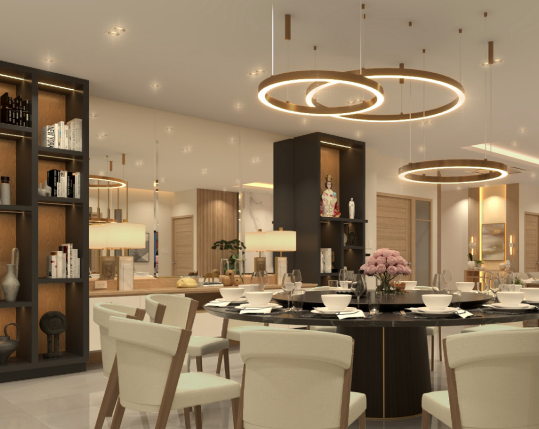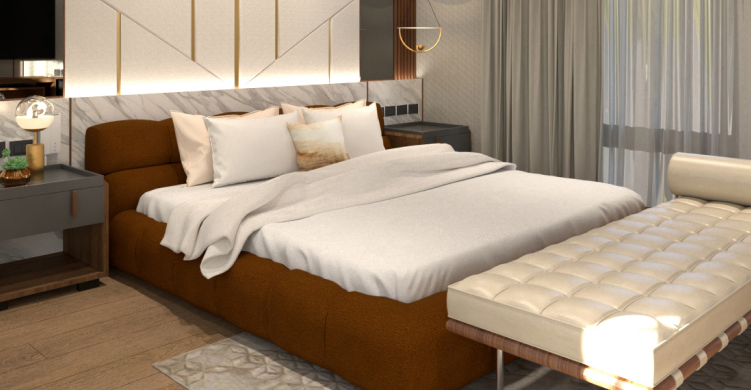Texture is a fundamental aspect of interior design that often gets overlooked, yet it plays a crucial role in creating a specific ambiance in a room. It pertains to the surface quality of an object, encompassing characteristics like roughness, smoothness, softness, hardness, glossiness, or matte finish.
Let’s discover the importance of texture in interior design and how it helps spruce up your space.
What Is Texture in Interior Design?
Texture in interior design isn’t just about the tactile sensation you get when you touch a surface. It’s also about the visual perception of a space. A room may have a visual texture depending on the materials, colors, patterns, and even the décor style.
Texture can come from various sources — the grainy surface of a wooden table, the plush comfort of a velvet sofa, the sleek coolness of a marble countertop, or the rough, rugged appeal of a brick wall. These textures create a multi-dimensional experience, visually and physically engaging our senses.
How Does Texture Impact Interior Design?
Texture has a substantial impact on the overall feel of a room. It can add depth and dimension, making a space more layered and interesting. For instance, a room with many smooth, shiny surfaces will give off a different vibe than one with many soft, plush textures.
Texture also plays a role in how comfortable a space feels. Soft, warm textures can make a room feel more cozy and inviting, while hard, cool textures can create a more formal, sophisticated atmosphere. Furthermore, it can influence the light in a room. Smooth, glossy surfaces reflect light and make a space feel brighter, while rough, matte surfaces absorb light and create a more muted, intimate feel.
What Is the Importance of Texture in Interior Design?
Texture should never be an afterthought in interior design; it’s a vital component that can make or break a room’s overall aesthetic and feel. Here are two significant ways that texture contributes to the world of interior design:
Texture Provides Balance
Just like colors, patterns, and proportions, textures need to be balanced within a space to prevent them from feeling too monotonous or overwhelming. A room with a variety of textures feels more balanced and visually interesting. For instance, pairing a sleek, shiny metal coffee table with a soft, plush rug creates a harmonious balance between hard and soft textures.
Texture Provides Visual Weight
Texture can also provide visual weight to a space. Rough textures make an object appear heavier and more grounded, while smooth textures give a lighter look. This can be used strategically to create a sense of balance and proportion in a room. For example, light and smooth-textured throw pillows can balance a large, rough-textured sofa.
What Are the Different Textures in Interior Design?
In interior design, texture comes in many forms and can be derived from many materials. Here are some common types of textures you might encounter:
Rough Textures
These include stone, raw wood, wool, and certain types of textiles. Rough textures can add a rustic, earthy feel to a space and are often used in industrial or farmhouse-style interiors.
Smooth Textures
Smooth textures can be found in materials like marble, glass, polished wood, and satin. These textures lend a sleek, modern look to a space and are commonly used in contemporary and minimalist designs.
Soft Textures
Soft textures are typically associated with fabrics like velvet, cotton, linen, and fur. They add a sense of warmth and coziness to a space and are essential for creating a comfortable, inviting atmosphere.
Hard Textures
Hard textures are characteristic of metal, granite, and concrete. They add a sense of solidity and structure to a space and are often used in modern and industrial designs.
10 Ways to Add Texture to Any Room in Your Home
From subtle accents to bold statements, textures can breathe more life into any room. Here are creative ways to infuse texture into every corner of your home or condo interior design, elevating its visual appeal and creating a more engaging and inviting space.
Layer Different Textures
One of the easiest ways to add texture is by layering different materials and finishes. This could be a mix of smooth, glossy surfaces with rough, matte ones or pairing soft textiles with hard metals.
Use Contrasting Fabrics
Mix and match fabrics like velvet, silk, linen, and wool to create an interesting interplay of textures. This can be done through curtains, rugs, cushions, or upholstery.
Add Textured Furniture
Consider furniture pieces with noticeable texture, like a leather sofa, a wicker chair, or a reclaimed wood table.
Decorate with Plants & Flowers
Live plants bring a touch of nature indoors and add a unique texture with their leaves and flowers.
Don’t Forget Lighting
The right lighting can highlight the textures already in a room. A glossy surface under direct light will look different with soft, diffused light.
Go Organic
Natural elements like stone, wood, and jute bring in organic textures that add warmth and depth to a space.
Try Sculptural Wall Decor
3D wall art can add texture to your walls, whether metalwork, wooden carvings, or ceramic pieces.
Use Layering Pillows and Throws
A simple way to add texture is by layering throw blankets and pillows in different fabrics and patterns on your bed or sofa.
Focus on Architectural Elements
Features, like exposed brick walls, wooden beams, or tiled floors, can act as built-in textures within a room.
Employ Upholstery Techniques
Techniques like tufting, quilting, or using nailhead trim can add texture to upholstered furniture.
Incorporating texture into your home decor is a great way to add visual interest and create a cozy, inviting space. Don’t be afraid to mix and match different textures and materials; this can add depth and character to any room.
Ready to incorporate more texture into your home? Connect with Rock Robins, a famous interior designer in the Philippines, to start designing a space that engages all your senses. Visit our website or call us at (02) 8663 0365 to set up a consultation with our interior designers. Let’s bring your vision to life with the perfect blend of colors, patterns, and textures!






